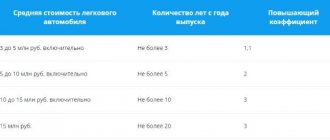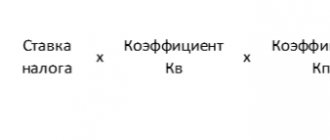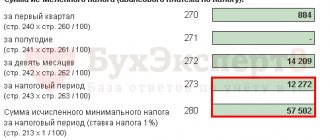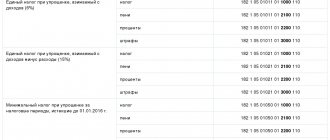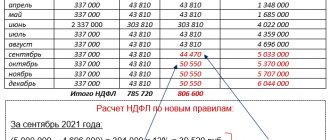One of the most controversial and complex types of taxation is VAT, that is, value added tax. Entrepreneurs have questions: is VAT a federal or regional tax, who should pay it, and within what timeframes are reports submitted? It is included in the federal category, since it is collected in accordance with all-Russian legislation, and all profits from its payment go to the federal budget.
Also see “From 2019, VAT increases to 20 percent.”
VAT is a type of indirect tax
Value added tax (VAT) is an indirect tax, a way to withdraw part of the cost of a product, work or service to the budget. VAT is present at all stages of the production process of goods, works and services and is transferred to the budget after implementation.
From this definition it is important for us to understand that this is, firstly, an indirect tax. Indirect tax is not paid directly from the enterprise’s funds, but is established as a premium to the price of a product or service. Thus, the company that sold the goods transfers part of the funds from this allowance to the budget.
The tax itself is paid by the final buyer, who immediately pays both the cost of the goods and VAT. By the way, it is important for travelers to remember that in some countries VAT is not written on price tags, and only at the checkout does the client learn that they have to pay a little more for the product they like.
Documents and reporting for VAT payment
The deadlines for paying VAT according to the Tax Code are established for all categories of payers: this type of taxation assumes a period of 3 months. After this period, no later than the 25th day of the next month, payers and tax agents are required to submit a declaration to the local inspectorate office, which records all transactions performed.
The document must contain invoice data - this is one of the most important types of documents for VAT payers. If this document is not available, the payer cannot take into account the amount of input tax before the operation, which means. Reduce added value and reduce your own tax base.
You also need to understand: VAT is a direct or indirect tax. With direct taxes, such as personal income tax, the enterprise actually loses profit, since it is forced to give part of its income to the state. In the case of VAT, profit is not lost, since the funds spent on paying the tax are included in the price of the final product for the consumer. Thus, VAT increases the final tax burden on buyers rather than on sellers.
In accordance with the Tax Code, VAT is classified as federal taxes (Clause 1, Article 13 of the Tax Code of the Russian Federation). This means that the full amount goes to the federal budget. VAT is also an indirect tax, since it is paid by the buyer and transferred directly to the budget by the seller.
Origin of VAT
Value added tax has existed in the economy for about 65 years. Before this, companies primarily paid sales tax, which was calculated on all revenue. This complicated accounting and increased the tax burden.
Maurice Lauret, the French Minister of Economy, Industry and Finance, came up with the idea of paying tax not on turnover, but on revenue. This tax was first applied in the colony of Côte d'Ivoire in 1958. And then it was already introduced throughout France. Lore's initiative turned out to be promising and showed its effectiveness. Now VAT has been introduced in almost all countries of the world.
In Russia, VAT appeared with economic reforms in 1992. From January 1, 2022, the rate of this tax in the Russian Federation is 20%, although recently it was 18%. In most European countries VAT is also 20%. And, for example, in Greece, Poland, Lithuania, Ireland the rate is slightly higher - 21-23%.
- The highest VAT is in Scandinavia - the Danes and Swedes have a tax of 25%.
- The lowest VAT is in Thailand, Singapore, Malaysia, the Dominican Republic, and Japan. There it does not exceed 10%.
But in the United States, the archaic sales tax continues to operate; its rate in different states for different types of products ranges from 3 to 15%.
Who pays VAT
An ordinary buyer may think that VAT is paid by the store or the manufacturing company. But this is not entirely true: in fact, every buyer pays the tax from his own funds, no matter whether he is an individual or a legal entity.
For example, if you bought groceries at a hypermarket, you can see the following calculations on your receipt:
| TOTAL: | 1414.00 |
| NON-CASH: | 1414.00 |
| VAT 20%: | 50.00 |
| VAT 10%: | 101.29 |
We see the total amount of purchases, as well as two types of VAT - 20% and 10% for a total amount of 151.29 rubles.
By the way, VAT can be preferential - 10% or 0%. This rate applies to socially significant goods and services. For example, for a number of products, medical and children's products, and others. A complete list of goods and services where preferential VAT can be applied is indicated in Art. 164 Tax Code of the Russian Federation.
Let's look at an example of how VAT appears. One company also buys another raw material, say, fabric for the production of trousers. The invoice will indicate VAT, which the buyer pays.
Then the company sews 100 products from the purchased fabric and sets a price for them. This price includes the cost of raw materials, the work of seamstresses, equipment costs, utility bills and other expenses, as well as the profit that is planned to be received after the sale of the goods. The same price includes VAT, which will be paid by the end buyer, or by a wholesaler who will buy the entire batch from the manufacturer at once.
After selling the goods, the company calculates the profit and immediately subtracts 20% of the tax from the income received, which was already included in the price and which the buyer paid. In this case, the company deducts the amount of VAT that it paid for the fabric - that is, it reduces the “trouser” VAT by the amount of tax on the material.
What if there was no VAT? Would the goods be cheaper? Most likely not, since other taxes would apply, as in the USA. There, the end consumer ultimately still pays sales tax, which also affects the final cost of the product.
What is the budget of taxes and fees
The budget of taxes and fees is called differently in different sources - tax budget, budget of tax obligations, budget of tax burden, etc.
The degree of detail of these budgets, the number of assessed taxes, and calculation methods depend on the requirements of management and the specifics of the activity, but in fact we can talk about the identity of the named financial forms that reflect and evaluate the same financial indicators.
The budget of taxes and fees is a financial report, according to which you can evaluate the effect of tax optimization schemes, as well as the amount of the company’s tax liabilities and the timing of their repayment.
Features of the budget of taxes and fees:
• tax liabilities of a company can be displayed both for the enterprise as a whole, and by type of activity, by division, regional basis, etc.;
• this budget can be either an independent financial form or a final form resulting from other budgets;
• a significant part of the final data of the budget of taxes and fees is adjustable, i.e. they change depending on the source data;
• tax and fee budget data is the basis for the formation of other budgets. For example, calculated tax liabilities must be included in the cash flow budget, the income and expense budget (if the source of their formation is the cost of production, in particular transport tax, or non-operating expenses in relation to property tax), in the accounts receivable budget, if there are overpayments, and accounts payable and other related budgets.
The budget of taxes and fees of the enterprise included:
• calculation of land tax;
• calculation of insurance premiums from wages.
The calculation of land tax does not depend on other budgets (unless we are talking about an investment project); it is calculated based on the cadastral value of the land and the tax rate.
If you do not take into account some specifics of the moment (for example, revaluation of the cadastral value), then, as a general rule, these data from the Budget of taxes and fees will not depend on certain financial parameters generated by the company.
And in order to calculate the amount of insurance premiums, you need to refer to the Budget of labor costs. That is, the Budget of taxes and fees will be in this case the resulting, as well as regulated. The amount of tax obligations of the enterprise will vary depending on the planned amount of remuneration. For example, plans to increase wages and pay bonuses will directly affect the amount of insurance premiums.
Based on the sales budget and the company’s expense budgets, the organization’s forecast profit for the next financial year was calculated - 5,550,250 rubles. Accordingly, the projected value of tax liabilities for income tax will be:
RUB 5,550,350 × 20% = 1,110,050 rub.
At the same time, management’s long-term plans (after the forecast period) include the renovation of the company’s production building, the cost of which is at least 5 million rubles.
The company has the money to do the repairs sooner. But taking into account the fact that repair costs can significantly reduce income tax obligations, and in subsequent periods they will form a loss, which is accepted in a special manner (no more than 50% of the tax base), it is more profitable to carry out repairs in the forecast period and save on income tax.
Calculation and payment of VAT
In large companies, separate accountants are assigned to calculate and pay VAT, since there is a lot of work in this area. Let's look at an example of how VAT is calculated.
A hardware store buys goods from suppliers—say, boxes of laundry detergent. The wholesaler ships a batch of powder worth 50,000 rubles, at the rate of 200 rubles per box. Thus, the store purchased 250 units of goods (boxes) for sale.
Keep records of exports and imports in the Kontur.Accounting web service. Simple accounting, payroll and reporting in one service
The 50,000 rubles that the store has already transferred to the supplier includes VAT of 20% (that is, 10,000 rubles), which the supplier will then transfer as a tax to the budget. For the store, this VAT will be input. Proof that the goods were purchased including VAT will be reporting documents: invoice, check, delivery note. In all these forms, the tax must be indicated.
The store then sells the powder at retail for 300 rubles per box, with VAT included. But since VAT is already included in the price of the purchased goods, the store receives a tax credit. The amount of VAT already paid for the product will be taken into account when calculating the retail sales tax.
The store will indicate in its quarterly VAT reporting that it first paid the tax to the supplier, receiving a “tax credit,” which allowed it to reduce the VAT, which will be charged on the retail price.
Insurance premium rates
The legislation of the Russian Federation provides for the following types of compulsory insurance: compulsory pension insurance (OPS); compulsory health insurance (CHI); compulsory social insurance in case of temporary disability and in connection with maternity (OSS); compulsory social insurance against accidents at work and occupational diseases (OSS NS and PZ).
Insurance is provided by contributions to the relevant funds. The procedure for calculating and paying contributions to compulsory health insurance, compulsory health insurance, compulsory health insurance is regulated by the norms of Chapter 34 of the Tax Code of the Russian Federation. Wherein:
- contributions to compulsory pension insurance are credited to the budget of the Pension Fund for the purpose of forming pension savings for citizens of the Russian Federation (Article 3 of the Federal Law of December 15, 2001 No. 167-FZ “On Compulsory Pension Insurance in the Russian Federation”);
- contributions for compulsory medical insurance go to the Federal Health Insurance Fund and are intended to be received by insured persons in case of need of free medical care (Article 3 of the Federal Law of November 29, 2010 No. 326-FZ “On Compulsory Medical Insurance in the Russian Federation”);
- contributions to OSS go to the Social Insurance Fund in order to provide citizens with benefits in cases of disability, pregnancy and childbirth, child care (Articles 1.2, 1.4 of the Federal Law of December 29, 2006 No. 255-FZ “On compulsory social insurance in case of temporary disability and in connection with maternity").
The procedure for calculating and paying contributions to OSS NS and PZ is regulated by Federal Law No. 125-FZ of July 24, 1998 “On compulsory social insurance against industrial accidents and occupational diseases.”
Contributions to OSS NS and PZ are credited to the budget of the Social Insurance Fund of the Russian Federation and form insurance compensation for harm caused to the life or health of individuals during the performance of their work duties (Article 3 of Law No. 125-FZ).
Tariffs of insurance premiums for compulsory medical insurance, compulsory medical insurance, compulsory medical insurance are regulated by paragraph 2 of Article 425 of the Tax Code of the Russian Federation.
For 2022, the maximum base for insurance premiums for compulsory health insurance at the basic tariff has been set in the amount of RUB 1,292,000. and for OSS - 912,000 rubles. (Resolution of the Government of the Russian Federation dated November 6, 2019 No. 1407).
Tariffs and procedures for paying insurance premiums for OSS NS and PZ were established for 2006 by Federal Law dated December 22, 2005 No. 179-FZ and continue to be applied in 2022 (Federal Law dated December 27, 2019 No. 445-FZ).
For payments in favor of individuals with disabilities, 60% of the generally established insurance tariff for contributions to OSS NS and PZ is provided (Article 2 of Law No. 445-FZ, Article 2 of Law No. 179-FZ).
The size of the insurance tariff for OSS NS and PZ depends on the main type of activity of an organization or individual (including an entrepreneur) and the class of professional risk corresponding to such activity (Article 21 of Law No. 125-FZ). Moreover, for separate divisions of the organization, separated into an independent classification unit (SCU), it is possible to set a tariff that is different from the main one for the organization. The separation of non-core activities into independent classification units allows policyholders to reduce premiums for insurance against accidents and occupational diseases.
| 1C:ITS For more information about the types of contributions for compulsory insurance, tariffs and payers, see the section “Legislative Consultations”. |
Confirmation of the type of economic activity in the Social Insurance Fund
Order of the Ministry of Health and Social Development of Russia dated January 31, 2006 No. 55 determined the procedure for confirming the types of economic activities of the insured for compulsory social insurance against industrial accidents and occupational diseases. According to paragraph 9 of Order No. 55, the decision on the allocation of divisions of the insurer to SKE is made by the territorial body of the Social Insurance Fund.
The procedure for isolating SKE:
- the policyholder submits to the territorial body of the Social Insurance Fund a complete package of documents in accordance with the list established by paragraph 8 of Order No. 55;
- The territorial body of the Social Insurance Fund sends the submitted documents to the fund for approval within 7 working days;
- within 20 working days from the date of receipt of the documents, the FSS reviews them for compliance with the requirements specified in Order No. 55, and informs the territorial body of the FSS at the place of registration of the policyholder about the results;
- the territorial body of the Social Insurance Fund notifies the policyholder within two weeks of the insurance rates in force since the beginning of the current year, corresponding to the classes of professional risk, for each SKE;
- The policyholder has the right to apply tariffs corresponding to the professional risk classes for each SKE. Contributions at the appropriate rate must be calculated from the beginning of the year.
Requirements for a unit to allocate it to SKE:
- implementation by divisions of the insured of types of economic activities that are not the main type of economic activity of the insured;
- maintenance by the insured of accounting of the financial and economic activities of the insured's divisions with reflection of the corresponding income in the report in Form 4-FSS, approved. by order of the Ministry of Health and Social Development of Russia dated February 28, 2011 No. 156n;
- submission to the territorial body of the Fund within the established time frame of Form 4-FSS;
- correspondence of the names of types of economic activities indicated by the policyholder in the confirmation certificate and specified in the application for the division of the policyholder's divisions into independent classification units within the policyholder;
- absence of outstanding debts for payment of insurance premiums, penalties and fines under OSS NS and PZ.
The type of economic activity must be confirmed annually no later than April 15 (clause 3 of the Procedure, approved by Order of the Ministry of Health and Social Development of Russia dated January 31, 2006 No. 55).
The deadline for confirmation of the main type of activity for 2022 is no later than 04/15/2020. The allocation of SKE is carried out annually as part of the procedure for confirming the main type of economic activity.
The list of supporting documents that must be submitted is also given in paragraph 3 of the Procedure, approved. Order No. 55.
Please note that documents to confirm the type of economic activity can be submitted not only in paper form, but also in electronic form (clause 8 of the Procedure, approved by Order No. 55). You can generate and send to the Social Insurance Fund all the necessary documents to confirm the main type of activity of the policyholder and allocate divisions in SKE in the 1C-Reporting service.
For more information about the service, see the 1C:ITS Portal.
What formulas are used to calculate VAT?
To calculate VAT, two formulas are used. The first is for calculating value added tax. It looks like this:
VAT charge = X * 20 / 100, where X is the price of the product without VAT
Let’s say a furniture manufacturer produced sofas and determined that the price of one unit of goods is 20,000 rubles. Now he needs to calculate the cost of the goods including VAT.
- 20,000 * 0.2 = 4,000 rubles - this is the amount of VAT, the seller adds it to the cost of the goods without VAT;
- 20,000 + 4,000 = 24,000 rubles - at this price the sofa will be sent to the store or to the end consumer.
The second formula is the allocation of VAT. To find out how much VAT is included in the price, you need to multiply the price including VAT by 20 and divide by 120:
VAT allocation = Y * 20 / 120, where Y is the price of the product including VAT
Let's return to the example with sofas. The store, having received a sofa from a supplier for 24,000 rubles, put it up for sale for 33,990. This price already includes value added tax in the amount of 33,990 * 20/120, namely 5,665 rubles.
Thus, the furniture store first received a tax credit by paying 4,000 rubles in taxes to the furniture factory, but then received 5,665 rubles in taxes from the buyer of the sofa, included in the retail price. Until the 25th day of the following month after the reporting month, the store is obliged to transfer to the budget the difference between these taxes, that is, 2,665 rubles.
This is the main difficulty of VAT accounting. First, you need to collect all the primary documents from the supplier, then receive all the documents from the buyer, calculate the VAT paid, received, and calculate the cost of the tax. In essence, a business in this situation is an operator for collecting taxes for the treasury.
What is VAT and how is it calculated?
Unlike personal income tax, VAT is an indirect tax: it is paid by the seller, but in fact it is paid by the buyer, since manufacturers and retailers include it in the final price of the product on the store shelf. The code devotes a separate chapter to this type of taxation due to the complexity of its calculation, reporting and payment for payers. The VAT taxation system is based on the following principles:
- The object of taxation under this tax is operations that are carried out in the chain of production and supply of goods to the final consumer.
- The tax base for it is the cost of goods, services or other tangible and intangible assets sold.
- Tax rate – it is set separately for each type of transaction and depends on several factors.
- Taxable period. In Russia it is 1 quarter, and the tax period completely coincides with the reporting period. Business representatives submit VAT tax reports electronically once a quarter. Also see “Tax period for VAT“.
The deadlines for paying taxes are established by the Tax Code. The amount calculated for the quarter is divided into three parts and paid monthly, payment is made by the 25th of each month. At the same time, only organizations that have chosen a general rather than a simplified taxation system work with this tax. If an entrepreneur chooses “simplified taxation”, a patent or taxation on imputed income, he will not have to pay VAT.
Briefly about the main thing
So, VAT is precisely the value added tax that the end buyer ultimately pays. Transactions with VAT for an enterprise have their positive and negative sides. The advantages are additional working capital, the disadvantages are that “serving” the tax requires additional efforts on the part of the accounting department, and if VAT is not transferred to the budget on time or the reporting is incorrectly completed, then the company faces a fine, penalties, even blocking the current account. Therefore, you should be careful when working with VAT.
The Kontur.Accounting web service will tell you how to calculate VAT correctly and without overpayments, what documents to create or request from suppliers in order to apply all deductions, reduce the amount of tax payable and avoid fines. The system makes it easy to keep records, pay salaries, submit reports, and monitor finances. The first two weeks are free for all newbies.

